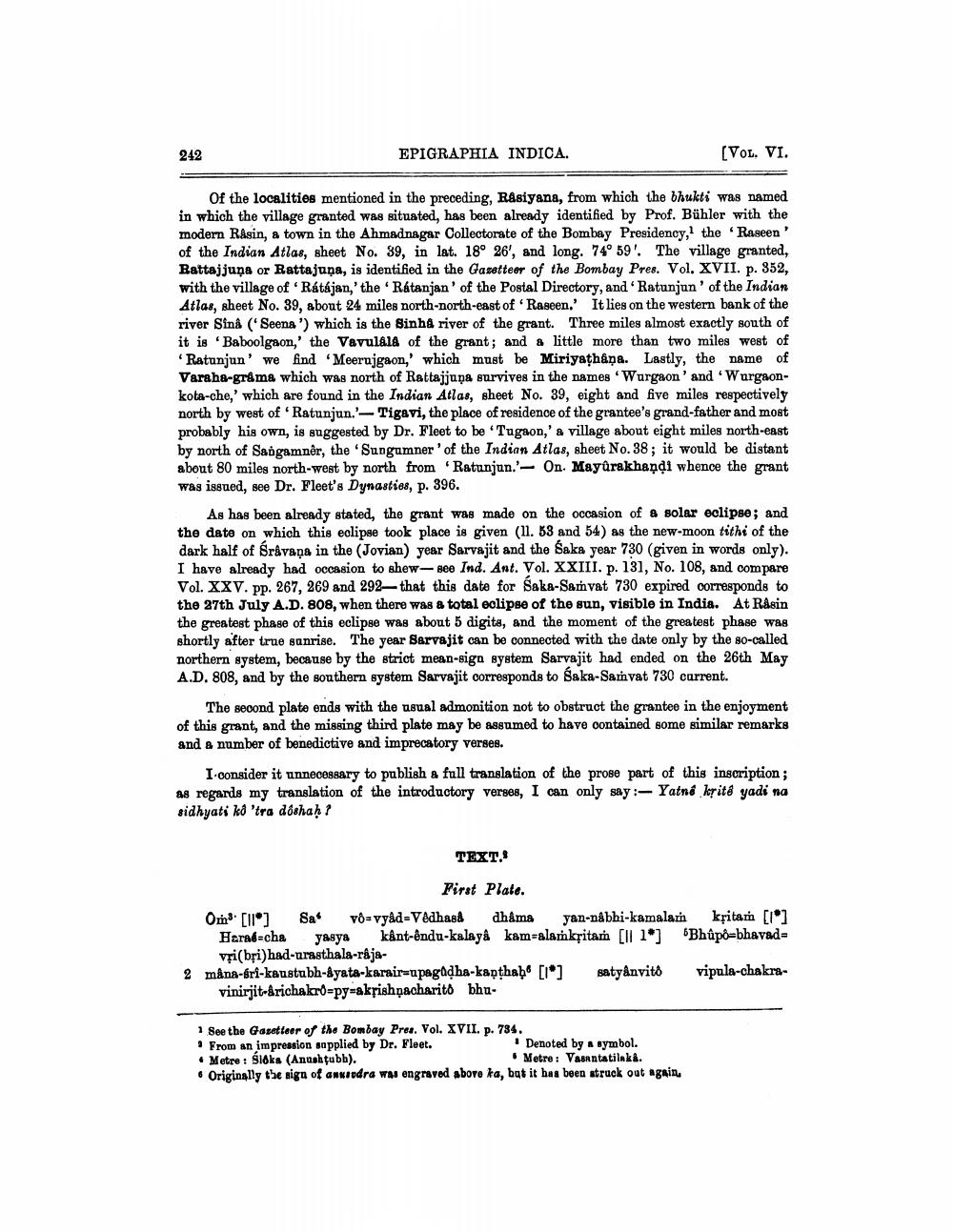________________
242
EPIGRAPHIA INDICA.
[VOL. VI.
Of the localities mentioned in the preceding, Råsiyana, from which the bhukti was named in which the village granted was situated, has been already identified by Prof. Bühler with the modern Råsin, a town in the Ahmadnagar Collectorate of the Bombay Presidency, the Raseen' of the Indian Atlas, sheet No. 39, in lat. 18° 26', and long. 74° 59'. The village granted, Battajjuņa or Rattajuna, is identified in the Gazetteer of the Bombay Pres. Vol. XVII. p. 352, with the village of Rátájan,' the Rátanjan of the Postal Directory, and 'Ratunjun' of the Indian Atlas, sheet No. 39, about 24 miles north-north-east of 'Raseen.' It lies on the western bank of the river Sina (Seena') which is the Sinh& river of the grant. Three miles almost exactly south of it is 'Baboolgaon,' the Vavulla of the grant; and a little more than two miles west of
Ratunjun' we find Meerujgaon,' which must be Miriyathina. Lastly, the name of Varaha-gråma which was north of Rattajjuộa survives in the names Wargaon' and 'Wargaonkota-che,' which are found in the Indian Atlas, sheet No. 39, eight and five miles respectively north by west of 'Ratunjun. Tigavi, the place of residence of the grantee's grand-father and most probably his own, is suggested by Dr. Fleet to be Tugaon,' a village about eight miles north-east by north of Sangamner, the 'Sungumner of the Indian Atlas, sheet No. 38; it would be distant about 80 miles north-west by north from Ratunjan.'- On. Mayûrakhandi whence the grant was issued, see Dr. Fleet's Dynasties, p. 396.
As has been already stated, the grant was made on the occasion of a solar eclipse; and the date on which this eclipse took place is given (11. 53 and 54) as the new-moon tithi of the dark half of Śrävana in the (Jovian) year Sarvajit and the Saka year 730 (given in words only). I have already had occasion to shew- see Ind. Ant. Vol. XXIII. p. 131, No. 108, and compare Vol. XXV. pp. 267, 269 and 292—that this date for Saka-Samvat 730 expired corresponds to the 27th July A.D. 808, when there was a total eclipse of the sun, visible in India. At Råsin the greatest phase of this eclipse was about 5 digits, and the moment of the greatest phase was shortly after true sunrise. The year Sarvajit can be connected with the date only by the so-called northern system, because by the strict mean-sign system Sarvajit had ended on the 26th May A.D. 808, and by the southern system Sarvajit corresponds to Saka-Samvat 730 current.
The second plate ends with the usual admonition not to obstruct the grantee in the enjoyment of this grant, and the missing third plate may be assumed to have contained some similar remarks and & number of benedictive and imprecatory verses.
I consider it unnecessary to publish a full translation of the proge part of this inscription; as regards my translation of the introductory verses, I can only say :- Yatné kşité yadi na sidhyati ko 'tra doshah?
TEXT.
First Plate. Om [1] Sa* v- vyad-Vedhasa dhama yan-nabhi-kamalam kritam [1]
Haral=cha yasya kant-endu-kalagâ kam-alamkṣitam [ll 1*] Bhûpô=bhavada
vri(bři)had-urasthala-raja2 måna-bri-kaustubh-ayata-karair=upagadba-kapthah [1] Satyanvito vipula-chakra
vinirjit-&richakro-pyakpishmacharito bhu
1 See the Gasetter of the Bombay Pres. Vol. XVII. p. 784. • From an impression supplied by Dr. Fleet.
• Denoted by a symbol. • Metre : sloks (Anashtubb).
Metre: Vasentatilaka. • Originally the sign of anxiodra was engraved aboro ka, bat it has been struck out again




